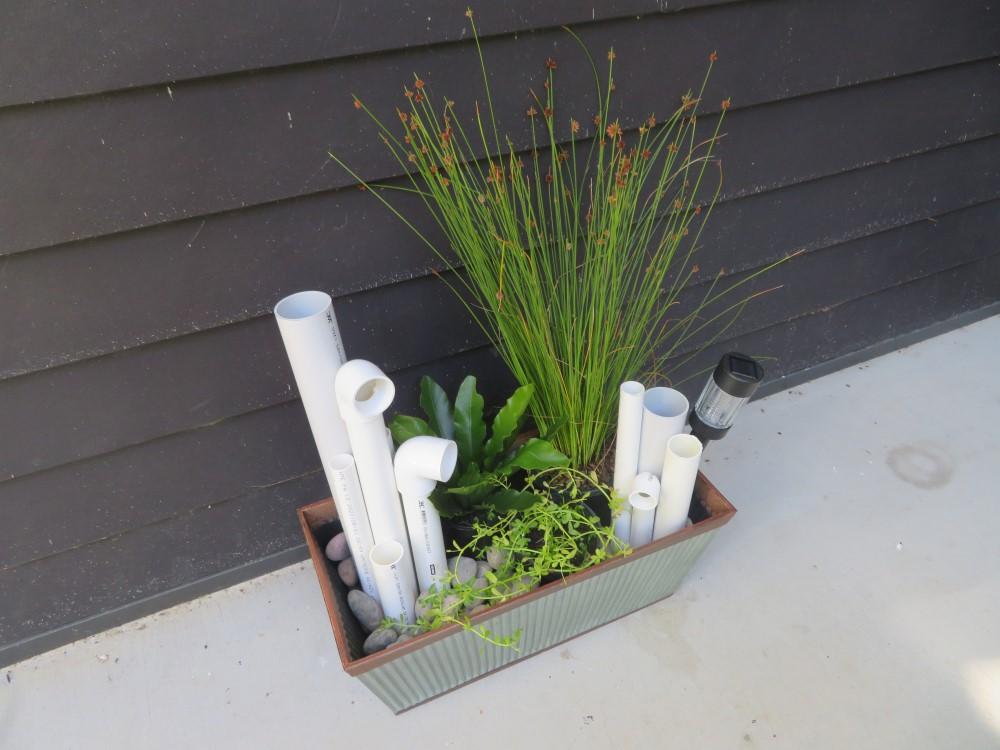How to make a frog hotel

Whilst frogs rely on bodies of water to survive, not all frogs live in water! Tree frogs in particular spend very little time in ponds and most only use them for breeding.
Tree frogs spend most of their lifetime amongst vegetation, and hiding in logs or frog hotels.
Creating a frog hotel is simple, follow the instructions below to get started.
Remember – this habitat is only suitable for tree frogs as they are able to climb slippery steep surfaces with the suction pads on their toes.
Materials:
- PVC pipes in three different widths and lengths (ideally 90mm, 40mm, and 25mm in width, and a minimum of 40cm in length)
- Bowl or tub that will hold water
- Gravel or pebbles
- Native water plants

Optional materials:
- Larger river stones or decorative rocks/logs
- Solar powered light
- 90* PVC elbow to fit above PVC pipes
- Pet friendly paint or low VOC paint for decoration
Method:
Step 1:
Cut your PVC pipes to different lengths (minimum of 40cm in length so that cane toads cannot jump in), and sand back the cut edges so they are smooth.
Optional: If using angled PVC elbows, fit these now.
Optional: If you are wishing to paint your pipes, do this beforehand and allow for the paint to dry.
Step 2:
Arrange the pipes in your chosen tub or bowl.
Step 3:
Have an assistant hold the pipes in place while you scoop small pebbles/gravel in around them until they stand upright on their own. Some additional gravel can be placed inside each pipe for extra support.
Step 4:
Place your water plant so that the rim of the plant pot sits just below the edge of the tub.
Step 5:
Fill the remainder of the tub with gravel, decorative rocks, and logs.
Step 6:
Add some water to the pipes and fill the bowl with water. Your frog hotel is now ready for guests! Place a solar light by your new frog hotel to attract moths and other insects for frogs to feed on at night.
Additional tips:
- Check your hotel every few days and top up with water when necessary. It is best to use water that is chlorine and chemical-free. You can achieve this by standing a bucket of tap water outdoors in the sun for 24 hours.
- To avoid mosquito activity, only fill the tub up to the same level as the rocks/pebbles.
- To prevent water from smelling, flush out water with dechlorinated water every 3-4 days to freshen up the water.
- Make sure you choose native plants that are happy to be in constantly wet soil. Some frog-friendly native plants include:
Above water level
- Maidenhair Fern, Adiantum atroviride
- Native Ginger, Alpinia caerulea
- Waterhyssop, Bacopa monniera
- Jointed Twig Rush, Baumea articulata
- Soft Twigrush, Baumea rubiginosa
- Bungwall, Blechnum indicum
- Binung Fern, Christella dentata
- Crinum Lily, Crinum pedunculatum
- Cyperus Sedge, Cyperus enervis
- Tall Sawsedge, Gahnia clarkei
- Red-Fruited Sawsedge, Gahnia cylindrica
- Saw-leafed Sedge, Gahnia sieberiana
- Scrambling Lily, Geitonoplesium cymosum
- Common Rush, Juncus usitatus
- Coral Fern, Lycopodiella cernua
- Bladderwort, Utricularia aurea
- Climbing Maiden Hair, Lygodium microphyllum
- Swamp Lobelia, Lobelia alata
- Creek Mat Rush, Lomandra hystrix
- Long-leafed Mat Rush, Lomandra longifolia
- Native Primrose, Ludwidgea octavalvis
- Milky Vine, Marsdenia rostrata
- Smartweed, Persicaria attenuate
- Wooly Frogsmouth, Philydrum lanugiosum
Submerged floating:
- Ferny Azolla, Azolla pinnata
- Waterhyssop, Bacopa monniera
- Jointed Twigrush, Baumea articulata
- Bungwall, Blechnum indicum
- Spike Rush, Eleocharis equisetina
- Tall Spike Rush, Eleocharis sphacelata
- Hydrilla, Hydrilla verticillata
- Shiny Nardoo, Marsilea mutica
- Water Snowflake, Nymphoides indica
- Swamp Lily, Ottelia ovatifolia
- Woolly Frogmouth, Philydrum lanuginosum
- Common Reed, Phragmites australis
- Water Ribbons, Triglochin procerum
- Streaked Arrow, Grass Triglochin procerum

If you have any questions or wanto to learn how we can help you support the natural environment on your property, join our Environmental Partnerships program.